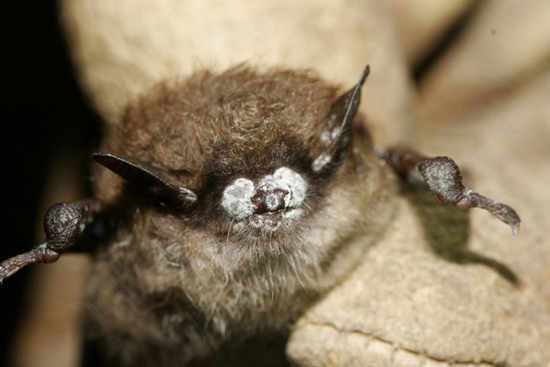Fungus Found to Be Killer of Little Brown Bats
Government study confirms work of CAS prof Kunz

This bat has lethal white-nose syndrome. Photo courtesy of Microbe World
On October 26, the day BU biologist Thomas Kunz was seriously hurt in a car accident, a government study confirmed that a fungus Kunz and other researchers have investigated is the mystery killer ravaging little brown bats in North America.
Saving the ecologically vital bats has been a passion for Kunz, an internationally known researcher whom colleagues and students have dubbed “Bat Man,” to his delight. Last March, he co-authored a paper calling for further research into the fungus, Geomyces destructans, which a U.S. Geological Survey study published in the journal Nature recently fingered as the source of lethal white-nose syndrome (WNS). Kate Langwig (GRS’15), a doctoral candidate at the Kunz-led BU Center for Ecology and Conservation Biology, reports that Kunz and colleagues at three other universities recently won a government grant to probe how bats’ social interactions may spread the fungus.
Last year, Kunz predicted that if WNS went unchecked, it could send the bats, found throughout the continent, into extinction in the Northeast. That study and Kunz’s related research, Langwig says, “provided critical information about dynamics of a novel bat pathogen, and helped to pave the way for confirmation of Geomyces destructans” as the cause. The breakthrough might help “wildlife managers target species and populations that are most at risk of infection,” curbing WNS, she says.
Kunz is receiving treatment at a rehabilitation center outside Boston. He suffered brain injuries after a car struck him in Toronto, where he was attending a bat research symposium.
WNS has killed more than a million bats, which eat bugs that destroy crops and spread disease, including mosquitoes carrying the West Nile virus. Named for the way it bleaches victims’ noses and other body parts, WNS causes the bats to wake early from hibernation and shed body fat at a time when their food source is in short supply, starving them to death. While Kunz’s work pointed to the fungus as the cause of the disease, it remained controversial because European bats exposed to the fungus have not been annihilated.
But after harvesting Geomyces destructans from sickened bats and then exposing hibernating lab bats to it, the results “provide the first direct evidence that G. destructans is the causal agent of WNS,” the study concludes. At the end of the trial, all treated bats were positive for WNS.
Kunz, a College of Arts & Sciences professor of biology, is a recipient of the University’s highest faculty honor, a William Fairfield Warren Distinguished Professorship.

Comments & Discussion
Boston University moderates comments to facilitate an informed, substantive, civil conversation. Abusive, profane, self-promotional, misleading, incoherent or off-topic comments will be rejected. Moderators are staffed during regular business hours (EST) and can only accept comments written in English. Statistics or facts must include a citation or a link to the citation.